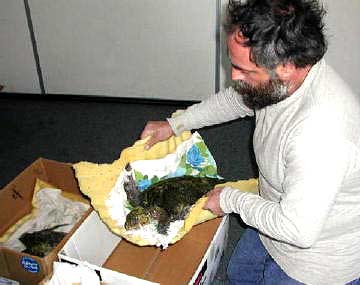The Big One That Didn’t Get Away — 13 November 2001The numbers began to mount all day today. Even with diminished winds, turtles kept getting tossed ashore along the Brewster-to-Orleans stretch of Cape Cod Bay. By late morning we had reached 15 cold-stunned sea turtles since the beginning of this stranding event on 7 November. Fourteen of the rarest sea turtles in the world, Kemp’s ridleys, and one rambunctious green turtle (in the lower left corner) — all juveniles.
The last sea turtle to saddle up for the trip was — of course — the gorgeous green, who couldn’t leave without playing up to the row of cameras and waving her flipper good-bye. Dennis placed her securely inside and departed for the mid-point rendezvous with the aquarium staff. And, as usual, that’s when the fun began. I headed back to Connemara Cottage to catch up on paperwork, process photos, and prepare daily reports. Nothing exciting so far. Then at 4 P.M. the phone rang. “You’re going to think this bizarre, Don, but I just got a call about a turtle on the tidal flats off Linnell Landing [in Brewster]. This guy says he was clamming on the low tide and ran across a turtle maybe a half mile out from the beach at a 45-degree angle from the landing. Do you want to try for it?” Well, of course, I’d try. But the situation was going to be dicey. The tide had turned and would be flooding back over the flats with a vengeance. Sunset was only minutes away and dark would come quickly to a mid-November Cape Cod. And if the turtle didn’t get rescued and had been sufficiently chilled by air and wind exposure all afternoon, it could succumb quickly. I hopped into the jeep and sped the 15 miles to Linnell, cursing the caller each and every mile of the trip for not moving the turtle above the high water mark, for leaving it vulnerably exposed, and for giving such skimpy and ambiguous directions. The tidal flats in this section of Brewster stretch forever and a small Kemp’s ridley sea turtle would be indistinguishable in the dark from any rock or clump of seaweed. I jumped from the car and raced across the beach just as the sun disappeared beneath the horizon, painting the western sky rosy orange.
Then it struck me. That rock has barnacles and I think it just moved. “Oh my! That couldn’t be . . . ” but of course, it was. A 91.2-pound loggerhead stared up at me, and I understood instantly why that intelligent caller had neglected to haul it the half mile across the flats to the beach. By the way, you may not think the .2 pound is worth mentioning, but then again, you didn’t have to carry this critter to safety, did you? I reached for the cell phone and called for backup. Dennis was en route back from the turtle exchange and would get here as soon as he could. In the meantime, it was loggerhead and me and in-rushing tide. Not a lot of leeway. And so, a hundred feet at a time we staggered shoreward, just staying ahead of the flood. For those who may find themselves in a similar circumstance, there’s a couple of other challenges posed by this situation — other than the dead weight of the turtle and its sharp edges. For one, she wasn’t really cold-stunned as one might expect with a critter of her mass. I suspect she had been moving slowly through the icy water and got surprised by the new moon low tide that dropped the bottom out from under her, leaving her high and dry on an enormous tidal flat. In other words, she was lively enough to protest my helpful intrusion. Secondly, with that much mass pressing down on an oozy surface, her plastron formed a tight suction cup against the bottom. Each lift was like breaking a vacuum seal.
Luckily as I reached within about 300 feet of the beach, Dennis arrived with relief. He brought a large open animal container into which we deposited the loggerhead, so that we could share the load for the rest of the trip to the jeep. We still stopped every couple of hundred feet — to admire an exquisite sunset.  Back at the Sanctuary, we settled her into dry dock for the night after preliminary assessment and processing. Her carapace measured a little over two feet long, and did I mentioned, she weighed 91.2 pounds. Tomorrow morning she’ll join the two Kemp’s ridleys we recovered tonight on the trip to the New England Aquarium — where we suspect she’ll become the prize and pride of this sea turtle stranding season. As a quick recap, we’ve had a total of 18 sea turtles so far in the first six days of this stranding event: 16 Kemp’s ridleys, 1 green and 1 loggerhead. | ||||||||||||




